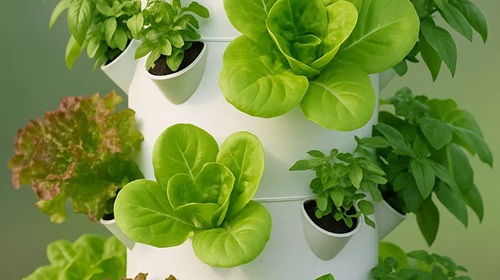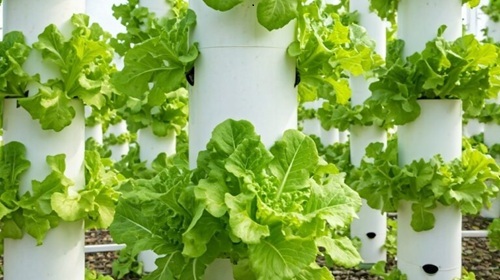Sep 11th 2025
Growing with Aeroponic Tower Gardens: How They Work and FAQs
An inventive twist on conventional gardening, aeroponic towers optimize productivity and development potential. If you're thinking about using them in your own gardening arrangement, this tutorial will explain the fundamentals of how they operate, why they're beneficial, and what you need to know.
What are Vertical Aeroponic Towers?
Vertical structures known as aeroponic towers are made to grow plants without the need for soil. Instead, nutrients are delivered by dripping (or misting) nutrient-rich water over the plant roots. With aeroponics - plant roots are exposed to air as opposed to being submerged underwater, as is the case with other hydroponic techniques.
How Aeroponic Towers Work
Suspending plant roots in air while supplying a nutritional solution on a periodic basis is the fundamental idea behind aeroponics. Here's a detailed explanation of how it operates:

- Plant Positioning: Plants are placed within the tower's pockets or slots. Inside the system, the roots hang loosely and are open to the atmosphere.
- Nutrient Delivery: Water containing nutrients is sent upward via the tower by a pump. Plant roots are watered as the water drips back down the system. This makes sure the roots get a healthy combination of oxygen, water, and minerals — all of which are essential for development.
- Oxygen Access: Plant roots receive high oxygen uptake since they are not buried underground, which promotes quicker and more robust development.
Aeroponics vs. Hydroponics
Although hydroponic gardening includes aeroponics, there is a key distinction between the two: while soil-less cultivation is a feature of both hydroponic and aeroponic systems, hydroponic systems typically submerge the plant's root zone under water. Conversely, aeroponic systems raise the plant's roots above the water reservoir.
Components of Aeroponic Towers
Choose Your Aeroponic System
Although aeroponic chambers vary in size and shape, they should have plenty of room to hold the plants you want to grow. Avoid skinny towers as this will inhibit root growth. Because they optimize space so well, especially in indoor and urban environments, vertical towers are becoming more and more popular as people discover them.
The Irrigation System
Place the water pump at the chamber's base, in the nutrient reservoir. The pump will periodically disperse the nutritional solution to the plant's roots within the chamber. Depending on the particular requirements of your plant, set the timer to provide watering for 10 to 15 minutes every hour, 12 to 16 hours a day. Note temperature will also play a role in your aeroponic watering schedule. During warmer temperatures you should increase watering frequency and/or duration.
Give Them Proper Light
When used indoors, aeroponic plants require additional light to maintain proper growth because they are grown away from the sun. LED grow lights should therefore be placed near the plant canopy. 8 to 10 hours is the minimum recommended lighting period. At ALTO Garden - we light our towers for 14 hours a day. Position the lights 6 to 12 inches above the plants for best development.
Nutrients for the Roots
Plant roots must receive proper nourishment for optimal growth. In order to provide your plants the proper nourishment, choose hydroponic nutrients that are appropriate, balanced, and all-around.
Select an NPK fertilizer (nitrogen, phosphorus, potassium) that dissolves in water so that it may be diluted in your reservoir. Keep in mind that the water setup for your aeroponic tower garden must permit watering at regular intervals as described above.
Temperature & Humidity
The ideal temperature range for plants in a vertical aeroponic tower garden is 65 to 78°F, and the humidity level should be kept at about 60%. In most instances it’s okay to use tap water to fill your reservoir. However, if you suspect extra chlorine or minerals in your tap water that can harm your plants, filtered or distilled water can be used instead.

FAQs
Which plants thrive best in an aeroponic tower garden?
Leafy greens, herbs, strawberries, tomatoes, and peppers are just a few of the many plants that can be grown in aeroponic tower gardens. However, it's important to choose plants that suit the unique requirements of the tower garden. For example, root vegetables (onions, carrots, potatoes, garlic, etc...) aren't suitable for these systems because they grow downward, "underground." Aeroponic towers work best with plants that grow upward.
How much space does is required?
Because aeroponic tower gardens grow vertically, they take up about 2 to 3 square feet and may be used inside or in limited spaces. This is actually why so many people find them appealing. Larger systems would need more space, but a tower garden with growing pods can fit on a patio or balcony with ease.
What is the water consumption of an aeroponic tower?
Because of their closed system architecture, aeroponic tower gardens use 95% less water than conventional gardening techniques. However, the size of the system, the quantity of plants, and the kinds of plants being cultivated all effect how much water is used. A tower garden that grows herbs and leafy greens typically uses one to two liters of water every week, depending on the maturity of the plants (larger plants consume more water).
What upkeep is required?
Monitoring pH and water levels are the primary maintenance activities. Giving your system a good cleaning every few months is also recommended. To encourage strong development, it's also essential to prune and harvest the plants on a regular basis.




